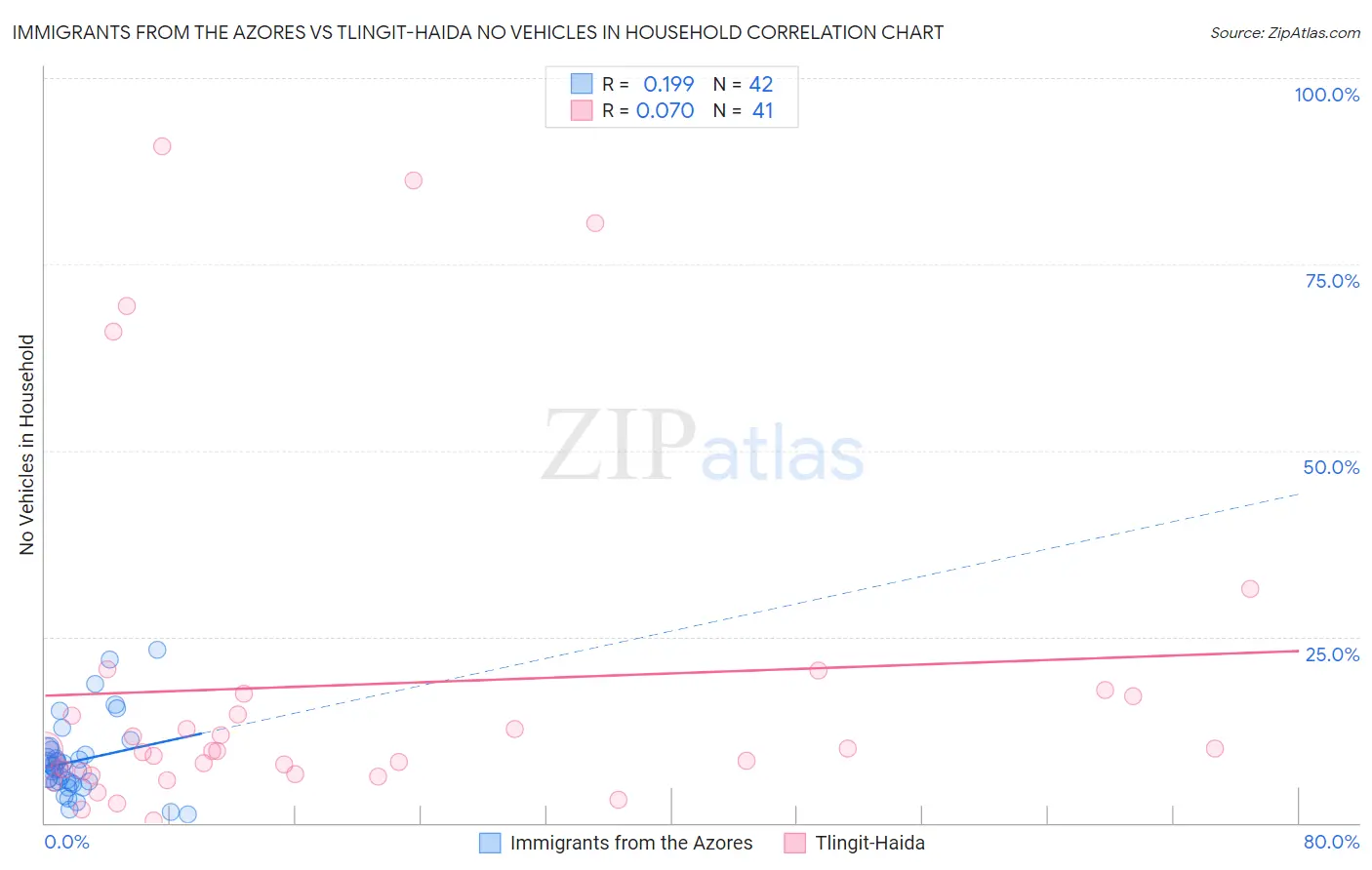Immigrants from the Azores vs Tlingit-Haida No Vehicles in Household
COMPARE
Immigrants from the Azores
Tlingit-Haida
No Vehicles in Household
No Vehicles in Household Comparison
Immigrants from the Azores
Tlingit-Haida
9.7%
NO VEHICLES IN HOUSEHOLD
88.2/ 100
METRIC RATING
131st/ 347
METRIC RANK
10.1%
NO VEHICLES IN HOUSEHOLD
72.5/ 100
METRIC RATING
153rd/ 347
METRIC RANK
Immigrants from the Azores vs Tlingit-Haida No Vehicles in Household Correlation Chart
The statistical analysis conducted on geographies consisting of 46,204,339 people shows a poor positive correlation between the proportion of Immigrants from the Azores and percentage of households with no vehicle available in the United States with a correlation coefficient (R) of 0.199 and weighted average of 9.7%. Similarly, the statistical analysis conducted on geographies consisting of 60,779,226 people shows a slight positive correlation between the proportion of Tlingit-Haida and percentage of households with no vehicle available in the United States with a correlation coefficient (R) of 0.070 and weighted average of 10.1%, a difference of 3.8%.

No Vehicles in Household Correlation Summary
| Measurement | Immigrants from the Azores | Tlingit-Haida |
| Minimum | 1.1% | 0.39% |
| Maximum | 23.2% | 90.9% |
| Range | 22.1% | 90.5% |
| Mean | 8.3% | 18.5% |
| Median | 7.4% | 9.7% |
| Interquartile 25% (IQ1) | 5.4% | 6.7% |
| Interquartile 75% (IQ3) | 9.6% | 17.2% |
| Interquartile Range (IQR) | 4.2% | 10.4% |
| Standard Deviation (Sample) | 5.0% | 23.6% |
| Standard Deviation (Population) | 4.9% | 23.4% |
Similar Demographics by No Vehicles in Household
Demographics Similar to Immigrants from the Azores by No Vehicles in Household
In terms of no vehicles in household, the demographic groups most similar to Immigrants from the Azores are Kenyan (9.7%, a difference of 0.070%), Burmese (9.7%, a difference of 0.20%), Immigrants from Oceania (9.7%, a difference of 0.37%), Syrian (9.7%, a difference of 0.39%), and Nicaraguan (9.7%, a difference of 0.46%).
| Demographics | Rating | Rank | No Vehicles in Household |
| Immigrants | Korea | 90.9 /100 | #124 | Exceptional 9.6% |
| Immigrants | Cameroon | 90.6 /100 | #125 | Exceptional 9.6% |
| Icelanders | 90.2 /100 | #126 | Exceptional 9.6% |
| Immigrants | Kenya | 89.7 /100 | #127 | Excellent 9.6% |
| Immigrants | Syria | 89.5 /100 | #128 | Excellent 9.6% |
| Nicaraguans | 89.5 /100 | #129 | Excellent 9.7% |
| Burmese | 88.8 /100 | #130 | Excellent 9.7% |
| Immigrants | Azores | 88.2 /100 | #131 | Excellent 9.7% |
| Kenyans | 88.0 /100 | #132 | Excellent 9.7% |
| Immigrants | Oceania | 87.1 /100 | #133 | Excellent 9.7% |
| Syrians | 87.1 /100 | #134 | Excellent 9.7% |
| Latvians | 85.1 /100 | #135 | Excellent 9.8% |
| Immigrants | South Africa | 85.0 /100 | #136 | Excellent 9.8% |
| Immigrants | Moldova | 84.6 /100 | #137 | Excellent 9.8% |
| Estonians | 84.2 /100 | #138 | Excellent 9.8% |
Demographics Similar to Tlingit-Haida by No Vehicles in Household
In terms of no vehicles in household, the demographic groups most similar to Tlingit-Haida are Sioux (10.1%, a difference of 0.020%), Salvadoran (10.1%, a difference of 0.030%), Immigrants from Congo (10.1%, a difference of 0.090%), Immigrants from Eastern Africa (10.0%, a difference of 0.23%), and Colombian (10.0%, a difference of 0.24%).
| Demographics | Rating | Rank | No Vehicles in Household |
| Hungarians | 80.0 /100 | #146 | Excellent 9.9% |
| Immigrants | Nicaragua | 79.8 /100 | #147 | Good 9.9% |
| Immigrants | Bosnia and Herzegovina | 79.1 /100 | #148 | Good 9.9% |
| Immigrants | Uganda | 76.1 /100 | #149 | Good 10.0% |
| Colombians | 73.9 /100 | #150 | Good 10.0% |
| Immigrants | Eastern Africa | 73.8 /100 | #151 | Good 10.0% |
| Immigrants | Congo | 73.0 /100 | #152 | Good 10.1% |
| Tlingit-Haida | 72.5 /100 | #153 | Good 10.1% |
| Sioux | 72.4 /100 | #154 | Good 10.1% |
| Salvadorans | 72.4 /100 | #155 | Good 10.1% |
| Immigrants | Micronesia | 70.9 /100 | #156 | Good 10.1% |
| Australians | 70.6 /100 | #157 | Good 10.1% |
| Spanish American Indians | 70.2 /100 | #158 | Good 10.1% |
| Immigrants | Indonesia | 69.3 /100 | #159 | Good 10.1% |
| Immigrants | Middle Africa | 65.7 /100 | #160 | Good 10.2% |